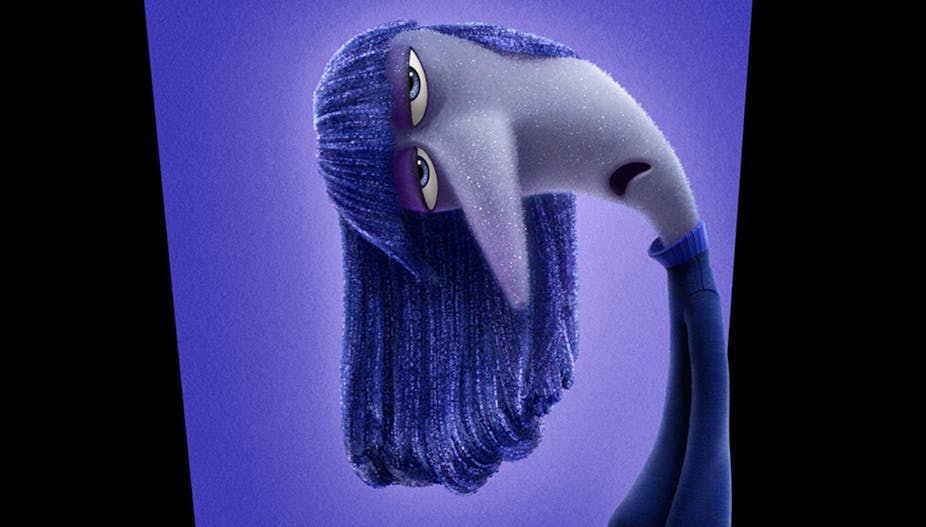Animated children’s films have long endeavoured to teach young viewers how to manage their emotions. Disney Pixar’s Inside Out (2015) made this task of emotional regulation literal.
Joy, Sadness, Anger, Fear and Disgust – the five basic emotions of protagonist Riley – became characters in her interior “control room”. Together, they guided her actions as she developed from a toddler to a pre-teen. Now, in the next instalment, Inside Out 2, Riley turns 13. This means the arrival of more “sophisticated” emotions – including Anxiety, Embarrassment, Envy and Ennui.
I am a researcher who has studied how boredom shapes media content and use. So I was particularly intrigued by the character of Ennui (Adèle Exarchopoulos), who embodies the mood of disengaged apathy more typically referred to as boredom.
Early in the film, Anxiety (Maya Hawke) explains to the older emotions “we all have a job to do” – adding that hers is to “plan for the future”. So, what job does Ennui have in the film, and how does this map onto the role of boredom in our everyday lives?
Since its inception during the early 19th century, the concept of “boredom” has been a topic of debate and disagreement. Philosophers and psychologists have observed that boredom can have both a positive and negative impact, suggesting that it plays a particularly important role in childhood and adolescent development.
In his influential discussion of boredom, the psychoanalyst Adam Phillips describes ennui as:
That state of suspended animation in which things are started and nothing begins, the mood of diffuse restlessness which contains that most absurd and paradoxical wish, the wish for a desire.
Or, as psychologists James Danckert and John Eastwood put it in their recent study, boredom’s state of inertia is above all “a call to action, a signal to become more engaged” – or to try something different.
Although it is associated with disengagement and apathy and can be a sign that we need to switch gears, my research shows how boredom has been increasingly targeted by media corporations. They have worked hard to consolidate the link between feeling bored and picking up our digital devices. Our phones are often promoted as tools for combating boredom, whenever and wherever it sets in.
Boredom, and the fear of it, motivates us to scroll mindlessly. But research has shown that the more we use smartphones to distract us from boredom, the more bored we risk becoming. This is a particular issue for teenagers. In recent decades, research has shown a correlation between increasing boredom and mental health difficulties.
Inside Out 2 doesn’t exactly deal with these potentially negative aspects of boredom. Instead, it doubles down on the positive developmental role that boredom plays in helping Riley to manage the intensity of teenage life. Throughout the film, the heavily French-accented Ennui lays draped across a sofa wearing a dark blue sweatsuit, staring dispassionately at her smartphone screen.
While the early concept design sketches pictured Ennui in pinkish-red, the final version re-imagined her in shades of inky blue and deep purple. As the film’s production designer explains: “We ultimately went with this dark, de-saturated blue-grayish shade – if I had to give it a name, it’d be ‘blah’.”
Ennui’s appearance, movements and verbal tics all exude the mental weariness, physical torpor and lack of interest of feeling bored.
Through most of the film, she takes second stage to Anxiety, the film’s main antagonist. Where Anxiety burns up the screen with her frenetic nervous energy, Ennui is a lurker who exudes what the French call je m’en foutisme – the distinctly teenage art of not giving a damn. Significantly, Ennui’s smartphone doubles as a remote for the control console, allowing her to modulate Riley’s emotions without ever getting up from the sofa.
This effortlessness is a core aspect of Ennui’s role in the film. She largely takes a back seat to the other emotions, responding only minimally to the drama with dramatic sighs, yawns, by rolling her eyes, or through sarcastic one-liners and put-downs. This sense of disinterested cool is how the film makes sense of boredom’s role in Riley’s emotional life, as she transitions from child to teenager.
At key moments in the film, however, Ennui takes control of the console, influencing Riley’s emotional experience by decreasing its intensity – for example, when Riley tries to impress the older friends she’s made at summer camp. When they name the deeply uncool boy band she went to see last summer, causing Anxiety and Embarrassment to appear, Ennui gets up from her sofa and announces: “I’ve been waiting for this moment.”
Ennui counterbalances Riley’s fear of how others perceive her with a heavy dose of sarcasm, which acts as a protective shield. At other key junctures, Ennui’s function is to keep the other emotions in check, helping to smooth out the emotional intensities of teenage life.
The way this helps temper Riley’s emotional experience speaks to sociologist Georg Simmel’s notion of a “blasé attitude”. In his essay The Metropolis and Mental Life (1903), Simmel described the blasé attitude as a consequence of the “rapidly shifting stimulations of the nerves which are thrown together in all their contrasts” in the modern metropolis.
Defined by a sense of apathetic indifference, Simmel argued that the blasé attitude provided a form of protection from the sensory intensity and nervous over-stimulation that grew out of city living.
It is arguably this version of boredom that dominates in the character of Ennui. By smoothing out Riley’s emotional highs and lows, Ennui offers her own inimitable form of protection from the overstimulation that comes with being a teenager.


